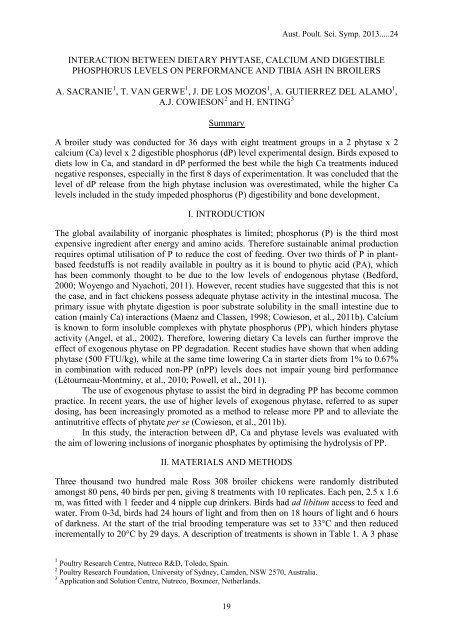APSS 2013 Proceedings - The University of Sydney
APSS 2013 Proceedings - The University of Sydney
APSS 2013 Proceedings - The University of Sydney
Create successful ePaper yourself
Turn your PDF publications into a flip-book with our unique Google optimized e-Paper software.
Aust. Poult. Sci. Symp. <strong>2013</strong>.....24<br />
INTERACTION BETWEEN DIETARY PHYTASE, CALCIUM AND DIGESTIBLE<br />
PHOSPHORUS LEVELS ON PERFORMANCE AND TIBIA ASH IN BROILERS<br />
A. SACRANIE 1 , T. VAN GERWE 1 , J. DE LOS MOZOS 1 , A. GUTIERREZ DEL ALAMO 1 ,<br />
A.J. COWIESON 2 and H. ENTING 3<br />
Summary<br />
A broiler study was conducted for 36 days with eight treatment groups in a 2 phytase x 2<br />
calcium (Ca) level x 2 digestible phosphorus (dP) level experimental design. Birds exposed to<br />
diets low in Ca, and standard in dP performed the best while the high Ca treatments induced<br />
negative responses, especially in the first 8 days <strong>of</strong> experimentation. It was concluded that the<br />
level <strong>of</strong> dP release from the high phytase inclusion was overestimated, while the higher Ca<br />
levels included in the study impeded phosphorus (P) digestibility and bone development.<br />
I. INTRODUCTION<br />
<strong>The</strong> global availability <strong>of</strong> inorganic phosphates is limited; phosphorus (P) is the third most<br />
expensive ingredient after energy and amino acids. <strong>The</strong>refore sustainable animal production<br />
requires optimal utilisation <strong>of</strong> P to reduce the cost <strong>of</strong> feeding. Over two thirds <strong>of</strong> P in plantbased<br />
feedstuffs is not readily available in poultry as it is bound to phytic acid (PA), which<br />
has been commonly thought to be due to the low levels <strong>of</strong> endogenous phytase (Bedford,<br />
2000; Woyengo and Nyachoti, 2011). However, recent studies have suggested that this is not<br />
the case, and in fact chickens possess adequate phytase activity in the intestinal mucosa. <strong>The</strong><br />
primary issue with phytate digestion is poor substrate solubility in the small intestine due to<br />
cation (mainly Ca) interactions (Maenz and Classen, 1998; Cowieson, et al., 2011b). Calcium<br />
is known to form insoluble complexes with phytate phosphorus (PP), which hinders phytase<br />
activity (Angel, et al., 2002). <strong>The</strong>refore, lowering dietary Ca levels can further improve the<br />
effect <strong>of</strong> exogenous phytase on PP degradation. Recent studies have shown that when adding<br />
phytase (500 FTU/kg), while at the same time lowering Ca in starter diets from 1% to 0.67%<br />
in combination with reduced non-PP (nPP) levels does not impair young bird performance<br />
(Létourneau-Montminy, et al., 2010; Powell, et al., 2011).<br />
<strong>The</strong> use <strong>of</strong> exogenous phytase to assist the bird in degrading PP has become common<br />
practice. In recent years, the use <strong>of</strong> higher levels <strong>of</strong> exogenous phytase, referred to as super<br />
dosing, has been increasingly promoted as a method to release more PP and to alleviate the<br />
antinutritive effects <strong>of</strong> phytate per se (Cowieson, et al., 2011b).<br />
In this study, the interaction between dP, Ca and phytase levels was evaluated with<br />
the aim <strong>of</strong> lowering inclusions <strong>of</strong> inorganic phosphates by optimising the hydrolysis <strong>of</strong> PP.<br />
II. MATERIALS AND METHODS<br />
Three thousand two hundred male Ross 308 broiler chickens were randomly distributed<br />
amongst 80 pens, 40 birds per pen, giving 8 treatments with 10 replicates. Each pen, 2.5 x 1.6<br />
m, was fitted with 1 feeder and 4 nipple cup drinkers. Birds had ad libitum access to feed and<br />
water. From 0-3d, birds had 24 hours <strong>of</strong> light and from then on 18 hours <strong>of</strong> light and 6 hours<br />
<strong>of</strong> darkness. At the start <strong>of</strong> the trial brooding temperature was set to 33°C and then reduced<br />
incrementally to 20°C by 29 days. A description <strong>of</strong> treatments is shown in Table 1. A 3 phase<br />
1 Poultry Research Centre, Nutreco R&D, Toledo, Spain.<br />
2 Poultry Research Foundation, <strong>University</strong> <strong>of</strong> <strong>Sydney</strong>, Camden, NSW 2570, Australia.<br />
3 Application and Solution Centre, Nutreco, Boxmeer, Netherlands.<br />
19
















